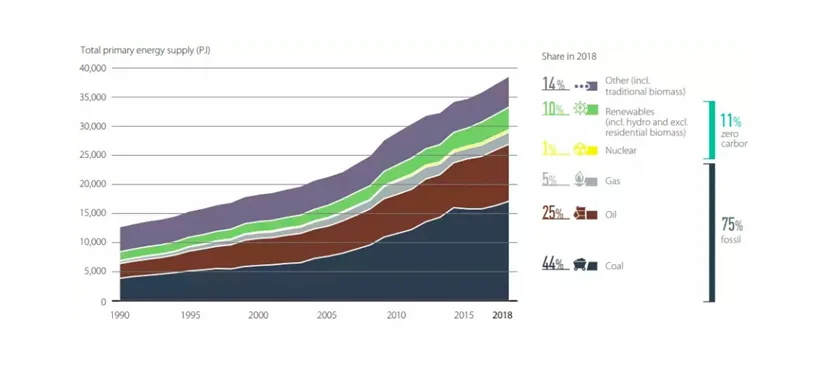Find the programme that meets your requirements and aspirations.
Apply nowStudent Blogs
- SPJIMR
- Blog
- India’s energy policy: Balancing the energy mix in India
India’s energy policy: Balancing the energy mix in India

In the year 2020, as a part of the COVID-19 stimulus package, the Prime Minister’s announcement to focus on coal mining and infrastructural development for transportation of coal, no one saw it coming. The landscape shifting to greener and cleaner sources of energy to meet the demand and consumption boosts the target of Coal India Limited, the largest fuel mining state-owned firm, by 18% to a 710 million. This is in anticipation of increased demand post the pandemic, which clearly indicates that only fossils can salvage in times of emergencies. Even though there is a strong paradigm shift to using alternate sources of energy, the debate about their efficiency, cost-effectiveness, and capability to cater to varying requirements has also remained prominent.
Let’s identify how India currently meets its energy requirements
The energy requirements for India are at a global share of 5.5%. Figure1 shows the current energy mix for all supplies in India. India became the fifth largest power generating nation in the world in the year 2017 and was the third largest power consuming nation in the year 2016. The trends of rise in the energy production have shown an average growth rate of 7% in India’s capacity, yet the demand in India outstrips the production by 7.5% approximately.

A huge half of the total generation for energy in India for all purposes is met by coal followed by oil and gas which together meet another majority of one-third generation in India.
Predicting India’s future energy consumption
As per studies, India’s population is expected to rise to 270 million by the end of 2040. This would cause a spike in the energy demand of the country. There will also be an increasing energy demand because of improving lifestyles, more than 100 smart cities missions, tripling economy agendas, rural electrification, and the focus on ‘Make in India’ stimulating growth and manufacturing in the Indian Micro, Small and Medium enterprises. The trends project the rise of energy demand in India to double by 11% of the global energy requirements. A total of 42% of this demand will be met by coal with 84% of generation being met by domestic production itself. This means that even though the focus on energy production has been on meeting the expanded energy requirements through renewable sources of energy, there will be an equal and consistent attention to develop the capacity of production of energy through coal. The current requirements of energy through coal met domestically is at 80% of the total energy production.
The role of an appropriate energy mix
In my opinion, to meet the increasing demand, an appropriate policy must be in place to upgrade the production of alternate sources of energy while simultaneously developing the capacities for utilising and producing the conventional energy sources effectively and efficiently. The Government of India has increased its focus to meet energy demands through the non-conventional sources of energy and has set up goals aligning with Sustainable Development Goals of the United Nations. According to these goals, India plans to ramp up its energy requirements to 450 GW by 2030, respectively. Though this addresses the demand for reducing carbon emissions from energy production, however, it is not without its challenges. Some of these challenges are the inconsistent policy initiatives by the government, lack of technology initiatives in storage and management of power generated from renewables and increasing demand for import of oil and gas. Further, with rising demand for different types of energy from different sectors, it is apparent that the dependency on the fossils to meet energy requirements in the country is not going to decrease in the long run. Even after the efforts of the government to shift the focus of energy production to alternate sources of energy by providing inputs in capacity installation and increasing efficiency, the production through fossils is expected to only grow in the future.
Then, how must India proceed with its energy production in the future?
Considering the future prediction and the current energy scenario with regards to energy mix and energy consumption in India, a hybrid system of energy production is recommended, supported by both the traditional sources of energy and the cleaner emerging fuels. While the constant and non-fluctuating demands of thermal power in homes and residential areas can be met through the new renewable sources of energy, the varying and heavy demands of industries and non-commercial areas can be satisfied using fossils.
Therefore, eliminating the use of fossils in India for the purpose of energy consumption is not completely possible. A better and more sustainable way to process and operate the production of energy to counter the externalities of climate change caused by them is the need of the hour.
Bibliography
- ” Wade, W. (2020, June 10). Everyone around the world is ditching coal – except India, China. Retrieved March 3, 2023, from https://theprint.in/economy/everyone-around-the-world-is-ditching-coal-except-india-china/438864/
- www.ETEnergyworld.com. (2019, November 28). Infographic: India’s Energy Mix – ET EnergyWorld. Retrieved March 3, 2023, from https://energy.economictimes.indiatimes.com/news/power/infographic-indias-energy-mix-2019/72277786
- N, S. (2018, March 26). India is now the world’s third-largest electricity producer. Retrieved March 3, 2023, from https://qz.com/india/1237203/india-is-now-the-worlds-third-largest-electricity-producer
- ibid
- Frangoul, A. (2020, March 03). India has some huge renewable energy goals. but can they be achieved? Retrieved March 3, 2023, from https://www.cnbc.com/2020/03/03/india-has-some-huge-renewable-energy-goals-but-can-they-be-achieved.html
- India likely to add 273 million people between 2019 and 2050: Un report. (n.d.). Retrieved March 3, 2023, from https://economictimes.indiatimes.com/news/politics-and-nation/india-likely-to-add-273-million-people-between-2019-and-2050-un-report/articleshow/69830509.cms
- Energy outlook 2020 – BP. (n.d.). Retrieved March 3, 2023, from https://www.bp.com/content/dam/bp/business-sites/en/global/corporate/pdfs/energy-economics/energy-outlook/bp-energy-outlook-2020.pdf
- ibid
- Department of Industry, S. (n.d.). Home Page. Retrieved March 3, 2023, from https://www.industry.gov.au/
- Mukta Patil, I. (2017, July 17). India’s new energy policy draft projects coal-fired capacity will double by 2040. is that feasible? Retrieved March 3, 2023, from https://scroll.in/article/843981/indias-new-energy-policy-draft-projects-coal-fired-capacity-will-double-by-2040-is-that-feasible
- ibid
- Janssen, R. (2017, July 29). India and the Energy Transition. Retrieved March 3, 2023, from https://energyindemand.com/2017/07/29/india-and-the-energy-transition/
- Electric mobility and development – home | ESMAP. (n.d.). Retrieved March 3, 2023, from https://www.esmap.org/sites/default/files/esmap-files/Electric_Mobility_and_Development.pdf
- ibid
- ibid
- Electric mobility and development – home | ESMAP. (n.d.). Retrieved March 3, 2023, from https://www.esmap.org/sites/default/files/esmap-files/Electric_Mobility_and_Development.pdf
- (n.d.). Retrieved March 3, 2023, from https://wgbis.ces.iisc.ac.in/energy/paper/Energy-trajectory-in-India/Overview.html
Recent Posts
- #DoCCDiaries: Community springs in the Bag Guler Panchayat July 9, 2024
- Experiential learning: My month-long advocacy internship with PGDM’s DoCC June 25, 2024
- My journey: Transforming lives through Abhyudaya June 6, 2024
- Discovering cutting-edge applications of AI and ML in the finance sector June 4, 2024
- #DoCCDiaries: Durbar: Fight against stigma for ‘dignity of profession’ May 28, 2024

